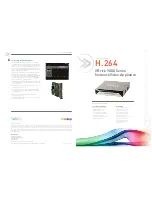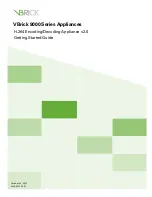
5-36
Parameters
Name
Range
Type
Default
Description
<segment_
number>
1 to 10k
Numeric
(integer only)
1
Selects the active segment number
Response
The 2074 will return the active segment number.
SEGment#<header><binary_block>
Description
This command will partition the waveform memory to smaller segments and will speed up memory
segmentation. The idea is that waveform segments can be built as one long waveform and then just use
this command to split the waveform to the appropriate memory segments. In this way, there is no need to
define and download waveforms to individual segments.
Using this command, segment table data is loaded to the 2074 using high-speed binary transfer in a similar
way to downloading waveform data with the trace command. High-speed binary transfer allows any 8-bit
bytes (including extended ASCII code) to be transmitted in a message. This command is particularly useful
for large number of segment. As an example, the next command will generate three segments with 12
bytes of data that contains segment size information.
SEGment#212<binary_block>
This command causes the transfer of 12 bytes of data (3 segments) into the segment table buffer. The
<header> is interpreted this way:
The ASCII "#" ($23) designates the start of the binary data block.
"2" designates the number of digits that follow.
"12" is the number of bytes to follow. This number must divide by 4.
The generator accepts binary data as 32-bit integers, which are sent in two-byte words. Therefore, the total
number of bytes is always 4 times the number of segments. For example, 36 bytes are required to
download 9 segments to the segment table. The IEEE-STD-488.2 definition of Definite Length Arbitrary
Block Data format is demonstrated in Figure 5-1. The transfer of definite length arbitrary block data must
terminate with the EOI bit set. This way, carriage-return (CR
– 0dH) and line feed (LF – 0aH) characters can
be used as segment table data points and will not cause unexpected termination of the arbitrary block data.
The segment table data is made of 32-bit words however, the GPIB link has 8 data bas lines and accepts
8-bit words only. Therefore, the data has to be prepared as 32-bit words and rearranged as six 8-bit words
before it can be used by the 2074 as segment table data. Figure 5-4 shows how to prepare the 32-bit work
for the segment start address and size. There are a number of points you should be aware of before you
start preparing the data:
Figure
5-4, Segment Address and Size Example
Summary of Contents for 5064
Page 26: ...1 5 Figure 1 2 ArbConnection The Control Panels Figure 1 3 ArbConnection The Wave Composer...
Page 71: ...2074 User Manual 2 18 This page intentionally left blank...
Page 145: ...2074 User Manual 3 74 Figure 3 48 Reading the 2074 Internal Temperature...
Page 220: ...4 ArbConnection Logging SCPI Commands 4 75 Figure 4 58 Log File Example...
Page 221: ...2074 User Manual 4 76 This page was intentionally left blank...
Page 333: ...2074 User Manual 7 2...
Page 359: ...2074 User Manual 7 28 This page was intentionally left blank...
Page 360: ...Appendices Appendix Title Page A Specifications A 1 1...
Page 361: ...2074 User Manual 2...
















































